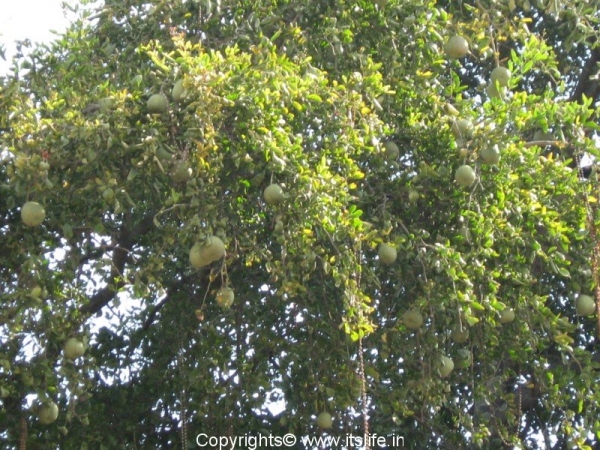Tridalam Trigunakaram|
Trinetrancha Triyaayudham|
Trijanma Paapa Samharam|
Eka Bilvam Shivarpanam||
The meaning of this above shloka/chanting in Sanskrit means offering of a bilvapatra (i.e., the trifoliate leaves) to the three eyed god Shiva who holds a Trishula (weapon with three sharp edges) will wash away the sins committed in the past 3 lives.
Picture1 – Bilva Tree
Plant Summary
Aegle Marmelos is the botanical name of the sacred plant Bilva or Stone Apple or Bael or Shivadruma. It belongs to the Rutaceae* family. Lord Shiva is fond of this tree and in the courtyard of every temple of Shiva; a Bilva tree will be planted. The leaves of the tree are trifoliate representing the three eyes of the Shiva. Pooja/ritual/prayers to Lord Shiva is incomplete without the offering of Bilvapathre/Bilva leaves. The Bilva leaves are also offered to Lord Ganesha during the 21 patra (leaves) pooja while chanting the below mantra: “Om Uma putraaya namaha, Vilva Patram Samarpayaami”
Bilva Tree grows in dry and arid regions on plains and hills in India, Sri Lanka, Bangladesh, Pakistan and South East Asia. Bilva tree grows to a height of 8 meters with thorns. The leaves are alternate, ovate, trifoliate and aromatic. The tender leaves and shoots are consumed as salad greens.
Picture3 – Bilva Leaves
The off-white flowers bloom in the month of May and has a sweet fragrance. Each flower has 5 petals and center with many stamens.
Picture4 – Bilva Flowers
Bilva Fruit
The fruits are woody, oval shaped with yellow pulp and they ripen during October/November. The fruits are 5 – 15 cm in diameter. The skin of the fruit is extremely hard, either a stone or a hammer is used to open the fruit. The fruit contains many seeds enclosed in fibrous hair and are surrounded by pulp, which has a pleasant aroma. This fruit is not found often in the market, whereas Wood Apple (Limonia acidissimia) is available in the markets. The Bilva Tree and Wood Apple tree are usually confused for one another.
Picture5, 5a – Bilva Fruit
Bilva fruit is either eaten fresh or dried. The fruit is cut into pieces and dried in the sun. Whenever the fruit has to be used, the dried pieces are boiled in water and sieved.
Picture6 – Bilva Tree
Medicinal Value
The roots, skin, fruits and the leaves of the Bilva tree are used for medicinal purpose. Bilva has astringent, edema lessening, anti-diarrhea, laxative and appetizer properties hence, can be used to cure both internal and external diseases.
Picture7 – Bilva Tree Crown
Knowledge capsule
Apart from Lord Shiva, this tree is a favorite as a larval food plant for Indian Swallowtail Butterfly and Common Lime or the Lemon Butterfly (Papilio demoleus).
Picture8 – Lemon Butterfly Photographed in Mysore
*Rutaceae, commonly known as the Rue or Citrus family, are trees or shrubs, with aromatic glands on the leaves and sometimes with thorns. The leaves are usually opposed and compound, and without stipules. (Stipules means outgrowths borne on either side of the base of a leafstalk)



